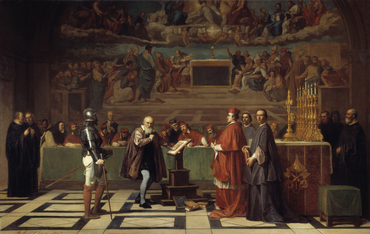
Back Inkwisisie Afrikaans Inquisition ALS Inquisición AN محاكم التفتيش Arabic محاكم التفتيش ARZ Inquisición AST İnkvizisiya Azerbaijani Инквизиция Bashkir Inquisition BAR Святая інквізіцыя Byelorussian

The Inquisition was a judicial procedure and a group of institutions within the Catholic Church whose aim was to combat heresy, apostasy, blasphemy, witchcraft, and customs considered deviant. Violence, torture, or the simple threat of its application, were used by the Inquisition to extract confessions and denunciations from heretics.[1] Studies of the records have found that the overwhelming majority of sentences consisted of penances, but convictions of unrepentant heresy were handed over to the secular courts, which generally resulted in execution or life imprisonment.[2][3][4] The Inquisition had its start in the 12th-century Kingdom of France, with the aim of combating religious deviation (e.g. apostasy or heresy), particularly among the Cathars and the Waldensians. The inquisitorial courts from this time until the mid-15th century are together known as the Medieval Inquisition. Other groups investigated during the Medieval Inquisition, which primarily took place in France and Italy, include the Spiritual Franciscans, the Hussites, and the Beguines. Beginning in the 1250s, inquisitors were generally chosen from members of the Dominican Order, replacing the earlier practice of using local clergy as judges.[5]
During the Late Middle Ages and the early Renaissance, the scope of the Inquisition grew significantly in response to the Protestant Reformation and the Catholic Counter-Reformation. During this period, the Inquisition conducted by the Holy See was known as the Roman Inquisition. The Inquisition also expanded to other European countries,[6] resulting in the Spanish Inquisition and the Portuguese Inquisition. The Spanish and Portuguese Inquisitions were instead focused particularly on the New Christians or Conversos, as the former Jews who converted to Christianity to avoid antisemitic regulations and persecution were called, the anusim (people who were forced to abandon Judaism against their will by violence and threats of expulsion) and on Muslim converts to Catholicism. The scale of the persecution of converted Muslims and converted Jews in Spain and Portugal was the result of suspicions that they had secretly reverted to their previous religions, although both religious minority groups were also more numerous on the Iberian Peninsula than in other parts of Europe, as well as the fear of possible rebellions and armed uprisings, as had occurred in previous times.
During this time, Spain and Portugal operated inquisitorial courts not only in Europe, but also throughout their empires in Africa, Asia, and the Americas. This resulted in the Goa Inquisition, the Peruvian Inquisition, and the Mexican Inquisition, among others.[7]
With the exception of the Papal States, the institution of the Inquisition was abolished in the early 19th century, after the Napoleonic Wars in Europe and the Spanish American wars of independence in the Americas. The institution survived as part of the Roman Curia, but in 1908 it was renamed the Supreme Sacred Congregation of the Holy Office. In 1965, it became the Congregation for the Doctrine of the Faith.[8] In 2022, this office was renamed the Dicastery for the Doctrine of the Faith.
- ^ Bishop, Jordan (2006-04-24). "Aquinas on Torture". New Blackfriars. 87 (1009): 229–237. doi:10.1111/j.0028-4289.2006.00142.x. ISSN 0028-4289.
- ^ "Internet History Sourcebooks Project". legacy.fordham.edu. Archived from the original on 20 March 2016. Retrieved 13 October 2017.
- ^ Peters, Edwards. "Inquisition", p. 67.
- ^ Lea, Henry Charles. "Chapter VII. The Inquisition Founded". A History of the Inquisition In The Middle Ages. Vol. 1. ISBN 1-152-29621-3. Archived from the original on 2007-10-13. Retrieved 2009-10-07.
- ^ Peters, Edward. "Inquisition", p. 54.
- ^ Cite error: The named reference
Lea1888was invoked but never defined (see the help page). - ^ Murphy, Cullen (2012). God's Jury. New York: Mariner Books – Houghton, Mifflin, Harcourt. p. 150.
- ^ "Congregation for the Doctrine of the Faith - Profile". Vatican.va. Archived from the original on 19 July 2013. Retrieved 13 October 2017.
© MMXXIII Rich X Search. We shall prevail. All rights reserved. Rich X Search